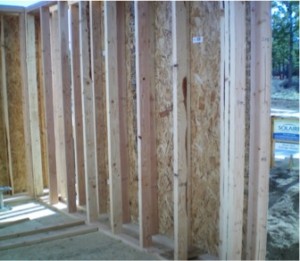 There has been a lot of talk lately about which wall assembly is better for achieving a truly high-performance wall, i.e., R-30 or better. The top contenders are exterior foam sheathing or off-set double-stud walls. They are both great, so you can’t go wrong. But for the sake of argument, let’s take a look at each.
There has been a lot of talk lately about which wall assembly is better for achieving a truly high-performance wall, i.e., R-30 or better. The top contenders are exterior foam sheathing or off-set double-stud walls. They are both great, so you can’t go wrong. But for the sake of argument, let’s take a look at each.
Many years ago Joe Lstiburek, building science rock star and founder of Building Science Corporation, introduced his “perfect wall” concept, although this perfection extends only to energy and moisture performance. There are other elements that I consider worthy of discussion: climate impact, cost and buildability.
Climate Impact
Foam sheathing, when mounted to the exterior of the wall, blocks heat loss through the wall framing and keeps the structural sheathing warm, essentially preventing condensation. One type of foam sheathing, expanded polystyrene (EPS), has lower greenhouse gas potential than other foam materials making it our favorite choice, despite being made of petroleum. Extruded polystyrene (XPS) and closed cell spray foam currently generate far more greenhouse gases than EPS. Wood framing sequesters greenhouse gases rather than generating them.
Cost
Foam material is considerably more expensive than fiberglass or cellulose insulation commonly used in double wall construction. Few contractors have experience with foam, and some have been deterred by a variety of little details, so labor costs can be high too. Double wall is generally less expensive for both materials and labor. Overall, costs for double wall tend to be lower than with exterior foam sheathing or other foam insulation products.
Buildability
Installing exterior EPS requires attention to a variety of details. For instance, furring must be installed over the foam, around windows and openings, at corners and other locations to prevent dampness and support siding. If you choose foam, make sure to get a product that contains a borate insect deterrence to keep little critters away.
With double wall just about any framer can achieve good results with proper guidance. The major complication is capping the double stud walls with plywood gusset. The only potential drawback to double wall construction is uncertainty about moisture condensation in thick walls. However my judgment over the last ten years is that wood-framed walls are moisture tolerant. To find out why, read part two of this series about moisture content.
I believe that you will get a great thermal envelope with either EPS or off-set double stud walls. Double-stud will probably cost less and flow more smoothly, and it has lower greenhouse gas impact. In the end, you’ll generally get a better house if your builder gets to do things his/her way. So, the builder’s opinion should carry a lot of weight in your decision about which wall system is best for you.
– Bruce Sullivan, Building Science Consultant, http://www.basezero.biz/
